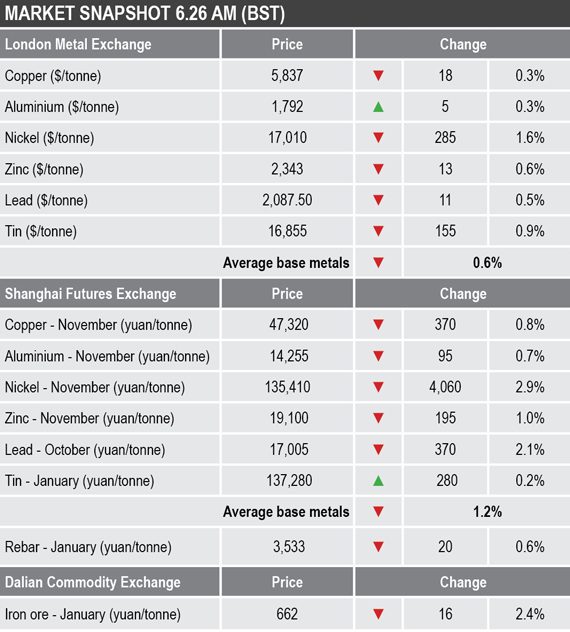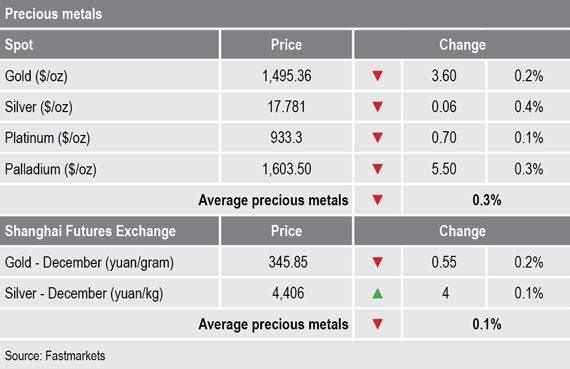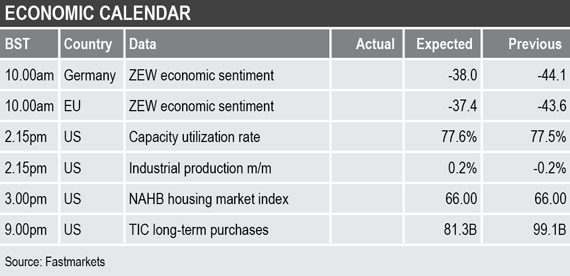For now, the rally on optimism that an interim United States-China trade deal may be forthcoming seems to have been overtaken by concerns over what damage high oil prices could bring.
- Crude oil prices remain high at $68.90 per barrel
- Equities in China remain under pressure
Base metals
Three-month base metals prices on the London Metal Exchange were for the most part weaker this morning, the exception being aluminium which was up by 0.3% to $1,792 per tonne. The others were down by an average of 0.8%, with copper off by 0.3% at $5,837 per tonne.
The worst performer was nickel that was down by 1.6% at $17,010 per tonne while a correction seems to be underway.
In China, the base metals traded on the Shanghai Futures Exchange were also mainly weaker, the exception being January tin which was up by 0.2%. The rest of the most-active contracts were down between 0.7% for November aluminium and 2.9% for November nickel. October lead was also down heavily with a 2.1% decline, while November copper was down by 0.8% at 47,320 yuan ($6,693) per tonne.
The spot copper price in Changjiang down was by 0.6% at 47,400-47,540 yuan per tonne and the LME/Shanghai copper arbitrage ratio was recently at 8.1, compared with 8.07 at a similar time on Monday.
Precious metals
Spot gold prices have given back some of the gains seen following the drone attack on Saudi Arabian oil facilities, with prices trading at $1,495.36 per oz, after a run-up to $1,512.15 per oz on Monday. Across the board, precious metals prices were down by an average of 0.3% this morning.
Wider markets
The spot Brent crude oil price was recently quoted at $68.90 per barrel, it closed September 13 at $60.12 per barrel. We expect volatile trading while the market tries to determine how much damage has been done and how vulnerable the oil supply chain is.
The yield on benchmark US 10-year treasuries has pulled back after the recent relief rally – it was recently quoted at 1.8377%, compared with 1.8616% on Monday. The German 10-year bund yield has also eased again and was recently quoted at -0.4870%, compared with -0.640% on Monday.
Asian equities were either weaker or little changed on Tuesday: The Hang Seng (-1.45%), the CSI 300 (-1.74%), the Kospi (+0.01%), the Nikkei (+0.06%), although the ASX 200 was up by 0.33%.
This follows a weaker performance in Western markets on Monday while they absorbed the higher oil price news. In the US, the Dow Jones Industrial Average closed down by 0.52% at 27,076.82, and in Europe, the Euro Stoxx50 closed down by 0.89% at 3,518.45.
Currencies
The dollar index is on the climb again and was recently quoted at 98.74 – the early September multi-year peak was at 99.38. The stronger dollar may also add downward pressure to metals prices.
As the dollar rises, the euro (1.0993), sterling (1.2406), the Australian dollar (0.6833) and the yen (108.22), are all weakening.
Key data
Tuesday’s economic releases contain data on German and European Union economic sentiment from the Zentrum fur Europaische Wirtschaftsforschung (ZEW) research institute, with US data on industrial production, capacity utilization, housing and Treasury International Capital (TIC) data on long-term purchases.
Today’s key themes and views
Overall most of the LME metals appear to have put in bases in recent weeks, which suggests much of the gloom about poor economic data was priced in for now and the next direction was likely to be set by what progress is made on an interim US-China trade deal, if any is forthcoming. But, if oil prices stay elevated then that could add another layer of gloom to the markets that may not be priced in yet.
Needless to say, any positive news on a trade deal is likely to trump concerns about higher oil prices.
Gold prices are looking vulnerable for now, the downward correction was interrupted by the attack on Saudi oil supply, but the rebound already seems to be waning. While we would not be surprised to see a deeper pullback in gold and silver, the need for havens has not gone away given the many political, economic and financial uncertainties the world faces.



